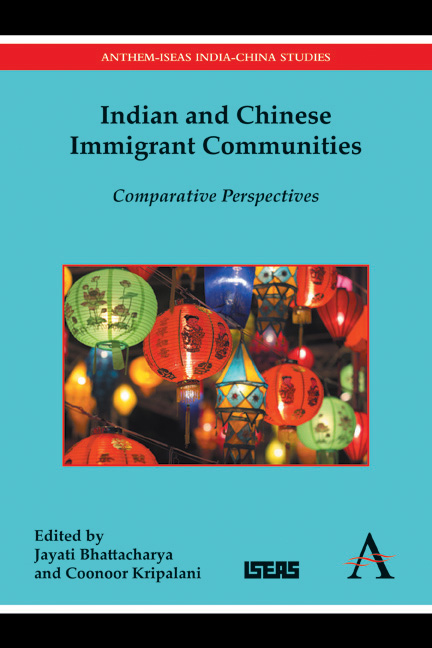Book contents
- Frontmatter
- Contents
- Foreword
- Acknowledgements
- Introduction
- Section I Historical Antecedents and the Question of Nationality
- Section II The Meeting Ground: Indians and Chinese in Southeast Asia
- 4 China's Nationality Laws and the Chinese Overseas
- 5 A Comparison of the Home Remittance Systems of Indian and Chinese Migrants in Southeast Asia: Nineteenth and Twentieth Centuries
- 6 Identity, Transnationalism and Corporate Development: Chinese Business in Malaysia
- 7 Beyond the Glitterati: The Indian and Chinese Jewellers of Little India, Singapore
- 8 Indian and Chinese Communities in Contemporary Burma: A Comparative Analysis of Their Presence and Influence
- 9 Expressions of Faith in Hindu Processional Festivals: Case Studies from Singapore and Malaysia
- 10 Beyond Boundaries? Hindu Spaces in the Chinatowns of Kolkata and Singapore
- Section III Indians in China and Chinese in India
- Section IV Across the Globe: Indian and Chinese Diasporas
- Postscript Shifting Worlds and Changing Identities: The Reshaping of the Chinese-Indian Communities in India after the 1962 “Sino-Indian Incident”
- List of Contributors
- Index
8 - Indian and Chinese Communities in Contemporary Burma: A Comparative Analysis of Their Presence and Influence
from Section II - The Meeting Ground: Indians and Chinese in Southeast Asia
Published online by Cambridge University Press: 05 December 2015
- Frontmatter
- Contents
- Foreword
- Acknowledgements
- Introduction
- Section I Historical Antecedents and the Question of Nationality
- Section II The Meeting Ground: Indians and Chinese in Southeast Asia
- 4 China's Nationality Laws and the Chinese Overseas
- 5 A Comparison of the Home Remittance Systems of Indian and Chinese Migrants in Southeast Asia: Nineteenth and Twentieth Centuries
- 6 Identity, Transnationalism and Corporate Development: Chinese Business in Malaysia
- 7 Beyond the Glitterati: The Indian and Chinese Jewellers of Little India, Singapore
- 8 Indian and Chinese Communities in Contemporary Burma: A Comparative Analysis of Their Presence and Influence
- 9 Expressions of Faith in Hindu Processional Festivals: Case Studies from Singapore and Malaysia
- 10 Beyond Boundaries? Hindu Spaces in the Chinatowns of Kolkata and Singapore
- Section III Indians in China and Chinese in India
- Section IV Across the Globe: Indian and Chinese Diasporas
- Postscript Shifting Worlds and Changing Identities: The Reshaping of the Chinese-Indian Communities in India after the 1962 “Sino-Indian Incident”
- List of Contributors
- Index
Summary
Tayok lo sha, Kala lo suu, Bama lo ma phyon ne.
(Burmese proverb: Earn like a Chinese, save like an Indian, but don't spend like a Bamar.)Introduction
Anyone wandering for the first time in Downtown Rangoon or in the streets of Mandalay would be struck by the visible Indian and Chinese influence – yet with a strong Burmanized flavour – that these vibrant Burmese cities still boast today. Bearded South Asian–looking shopkeepers wearing longyi (sarongs), chewing betel or puffing bidi-type Burmese cigars (cheroots) under huge Bollywood movie posters, the abundance of Chinese signboards displayed in gold, or the numerous shops selling Yunnan-made televisions – all are common snapshots. The Indian cultural influence on Burma is certainly the more obvious to the outsider: a Theravada Buddhist legacy, a Burmese language and script derived from Pali and Sanskrit are indeed palpable heritages. But the Chinese cultural impact on the country is deeply rooted too. Ancient migrations poured southward, from Central and Southwest China down to the Irrawaddy basin. In fact, nothing reflects the cultural Sino-Indian node that is Burma better than the Burmese way of dressing: Indian longyi down below, Chinese Mao-style shirt on top.
But it was in the age of colonial empires that Burma became far more open to Indian and Chinese demographic, cultural and commercial thrusts than ever before. The British Raj (1826–1948) fostered massive migrations of Indian communities, and to a lesser extent Chinese settlers and seasonal workers, into the Burmese colonial province. Extensive academic research has been done over the past decades on this phenomenon. However, the contemporary political difficulties of Burma call for a reassessment of the current situation of the Burmese Indian and Chinese communities. Six decades after independence from British rule, it is estimated that still one-tenth of the 55-million-strong Burmese population might have Indian or Chinese origins, however remote their linkages are to India or China's modern societies and cultures. This article compares the significance of these communities in post-1988 Burma.
- Type
- Chapter
- Information
- Indian and Chinese Immigrant CommunitiesComparative Perspectives, pp. 109 - 136Publisher: Anthem PressPrint publication year: 2015



